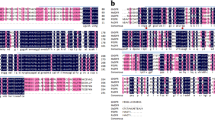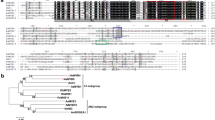Abstract
The Arabidopsis PAP1 gene (At1g56650) encodes the MYB75 transcription factor, which has been demonstrated to essentially regulate the biosynthesis of anthocyanins. Our previous study showed that ectopic expression of the PAP1 gene led to high pigmentation of anthocyanins in all tissues of transgenic tobacco plants. In order to understand the mechanisms of how PAP1 regulates anthocyanin biosynthesis and what can regulate the function of PAP1, we have established PAP1 transgenic tobacco callus cultures. Phenotypically different calli including anthocyanin-producing red and anthocyanin-free white calli lines were differentially induced from the same genotype of PAP1 transgenic plants. RT-PCR analysis showed that the expression of the PAP1 transgene was similar in the two types of calli, indicating that the transgenic red and white calli had differential responses to the regulation of PAP1. The growth of transgenic red calli followed a “sigmoid-like” curve in a 25-day callus culture period, during which the time course obviously impacted the profiles and the average levels of anthocyanins even though the expression of the PAP1 transgene was constitutive. A HPLC–UV–ESI-mass spectrum-based profiling characterized nine anthocyanin molecules (e.g., 595, 579 and 609 m/z) in the transgenic red calli over the course of the culture period. Cyanidin, pelargonidin, and peonidin were the major anthocyanidins identified by HPLC-mass spectrum analysis. We have demonstrated that dark, nitrogen nutrients, and auxin apparently affect the anthocyanin profiles in PAP1 transgenic callus cultures; and suggest that these cell cultures are an appropriate system to study the regulatory function of PAP1 on the anthocyanin biosynthesis at post-transcriptional level in vivo.








Similar content being viewed by others
Abbreviations
- 2, 4-D:
-
2, 4-Dichlorophenoxyacetic acid
- IAA:
-
Indole-3-acetic acid
- MS:
-
Murashige and Skoog
- NAA:
-
Naphthalene acetic acid
- PAP1:
-
Production of anthocyanin pigment 1
References
Borevitz JO, Xia Y, Blount J, Dixon RA, Lamb C (2000) Activation tagging identifies a conserved MYB regulator of phenylpropanoid biosynthesis. Plant Cell 12:2383–2394
Cominelli E, Gusmaroli G, Allegra D, Galbiati M, Wade HK, Jenkins GI, Tonelli C (2008) Expression analysis of anthocyanin regulatory genes in response to different light qualities in Arabidopsis thaliana. J Plant Physiol 165:886–894
Dixon RA, Xie DY, Sharma SB (2005) Proanthocyanidins—a final frontier in flavonoid research? New Phytol 165:9–28
Do CB, Cormier FO (1991a) Effects of high ammonium concentrations on growth and anthocyanin formation in grape (Vitis vinifera L.) cell suspension cultured in a production medium. Plant Cell Tissue Organ Cult 27:169–174
Do CB, Cormier FO (1991b) Accumulation of peonidin 3-glucoside enhanced by osmotic stress in grape (Vitis vinifera L.) cell suspension. Plant Cell Tissue Organ Cult 24:49
Dougall DK, Johnson JM, Whitten GH (1980) A clonal analysis of anthocyanin accumulation by cell cultures of wild carrot. Planta 149:292–297
Fujita Y, Hara Y, Ogino T, Suga C (1981a) Production of shikonin derivatives by cell suspension cultures of Lithospermum erythrorhizon. Plant Cell Rep 1:59–60
Fujita Y, Hara Y, Suga C, Morimoto T (1981b) Production of shikonin derivatives by cell suspension cultures of Lithospermum erythrorhizon. Plant Cell Rep 1:61–63
Fujita Y, Takahashi S, Yamada Y (1985) Selection of cell lines with high productivity of shikonin derivatives by protoplast culture of Lithospermum erythrorhizon cells. Agric Biol Chem 49:1755–1759
Gonzalez A, Zhao M, Leavitt JM, Lloyd AM (2008) Regulation of the anthocyanin biosynthetic pathway by the TTG1/bHLH/Myb transcriptional complex in Arabidopsis seedlings. Plant J 53:814–827
Hall RD, Yeoman MM (1986) Temporal and spatial heterogeneity in the accumulation of anthocyanins in cell cultures of Catharanthus roseus (L.) G.Don. J Exp Bot 37:48–60
Hirose M, Yamakawa T, Kodama T, Komamine A (1990) Accumulation of betacyanin in Phytolacca americana cells and of anthocyanin in Vitis sp. cells in relation to cell division in suspension cultures. Plant Cell Physiol 31:267–271
Lea U, Slimestad R, Smedvig P, Lillo C (2007) Nitrogen deficiency enhances expression of specific MYB and bHLH transcription factors and accumulation of end products in the flavonoid pathway. Planta 225:1245–1253
Lillo C, Lea US, Ruoff P (2008) Nutrient depletion as a key factor for manipulating gene expression and product formation in different branches of the flavonoid pathway. Plant Cell Environ 31:587–601
Lloyd JC, Zakhleniuk OV (2004) Responses of primary and secondary metabolism to sugar accumulation revealed by microarray expression analysis of the Arabidopsis mutant, pho3. J Exp Bot 55:1221–1230
Makunga NP, van Staden J, Cress WA (1997) The effect of light and 2, 4-D on anthocyanin production in Oxalis reclinata callus. Plant Growth Regul 23:153–158
Meyer HJ, Staden J (1995) The in vitro production of an anthocyanin from callus cultures of Oxalis linearis. Plant Cell Tissue Organ Cult 40:55–58
Misson J, Raghothama KG, Jain A, Jouhet J, Block MA, Bligny R, Ortet P, Creff A, Somerville S, Rolland N, Doumas P, Nacry P, Herrerra-Estrella L, Nussaume L, Thibaud M-C (2005) A genome-wide transcriptional analysis using Arabidopsis thaliana Affymetrix gene chips determined plant responses to phosphate deprivation. PNAS 102:11934–11939
Mizukami H, Tomita K, Ohashi H, Hiraoka N (1988) Anthocyanin production in callus cultures of roselle (Hibiscus sabdariffa L.). Plant Cell Rep 7:553–556
Mizukami H, Tomita K, Ohashi H (1989) Anthocyanin accumulation and changes in activities of phenylalanine ammonia-lyase and chalcone synthase in roselle (Hibiscus sabdariffa L.) callus cultures. Plant Cell Rep 8:467–470
Morcuende R, Bari R, Gibon Y, Zheng W, Pant BD, Blasing O, Usadel B, Czechowski T, Udvardi MK, Stitt M, Scheible W-R (2007) Genome-wide reprogramming of metabolism and regulatory networks of Arabidopsis in response to phosphorus. Plant. Cell Environ 30:85–112
Mori T, Sakurai M (1994) Production of anthocyanin from strawberry cell suspension cultures; effects of sugar and nitrogen. J Food Sci 59:588–593
Muller R, Morant M, Jarmer H, Nilsson L, Nielsen TH (2007) Genome-wide analysis of the Arabidopsis leaf transcriptome reveals interaction of phosphate and sugar metabolism. Plant Physiol 143:156–171
Murashige T, Skoog F (1962) A revised medium for rapid growth and bioassays with tobacco tissue culture. Physiol Plant 15:473–497
Ozeki Y, Komamine A (1985) Changes in activities of enzymes involved in general phenylpropanoid metabolism during the induction and reduction of anthocyanin synthesis in a carrot suspension culture as regulated by 2, 4-D. Plant Cell Physiol 26:903–911
Ozeki Y, Komamine A (1986) Effects of growth regulators on the induction of anthocyanin synthesis in carrot suspension cultures. Plant Cell Physiol 27:1361–1368
Rajendran L, Ravishankar GA, Venkataraman LV, Prathiba KR (1992) Anthocyanin production in callus cultures of Daucus carota as influenced by nutrient stress and osmoticum. Biotechnol Lett 14:707–712
Solfanelli C, Poggi A, Loreti E, Alpi A, Perata P (2006) Sucrose-specific induction of the anthocyanin biosynthetic pathway in Arabidopsis. Plant Physiol 140:637–646
Stracke R, Werber M, Weisshaar B (2001) The R2R3-MYB gene family in Arabidopsis thaliana. Curr Opin Plant Biol 4:447–456
Teng S, Keurentjes J, Bentsink L, Koornneef M, Smeekens S (2005) Sucrose-specific induction of anthocyanin biosynthesis in Arabidopsis requires the MYB75/PAP1 gene. Plant Physiol 139:1840–1852
Tohge T, Nishiyama Y, Hirai MY, Yano M, Nakajima J, Awazuhara M, Inoue E, Takahashi H, Goodenowe DB, Kitayama M, Noji M, Yamazaki M, Saito K (2005) Functional genomics by integrated analysis of metabolome and transcriptome of Arabidopsis plants over-expressing an MYB transcription factor. Plant J 42:218–235
Vanderauwera S, Zimmermann P, Rombauts S, Vandenabeele S, Langebartels C, Gruissem W, Inze D, Van Breusegem F (2005) Genome-wide analysis of hydrogen peroxide-regulated gene expression in Arabidopsis reveals a high light-induced transcriptional cluster involved in anthocyanin biosynthesis. Plant Physiol 139:806–821
Walker AR, Davison PA, Bolognesi-Winfield AC, James CM, Srinivasdan N, Blundell TL, Esch JJ, Marks MD, Gray JC (1999) The TRANSPARENT TESTA GLABRA 1 locus, which regulates trichome differentiation and anthocyanin biosynthesis in Arabidopsis, encodes a WD40 repeat protein. Plant Cell 11:1337–1350
Weigel D, Ahn JH, Blazquez MA, Borevitz JO, Christensen SK, Fankhauser C, Ferrandiz C, Kardailsky I, Malancharuvil EJ, Neff MM, Nguyen JT, Sato S, Wang Z-Y, Xia Y, Dixon RA, Harrison MJ, Lamb CJ, Yanofsky MF, Chory J (2000) Activation tagging in Arabidopsis. Plant Physiol 122:1003–1014
Xie D-Y, Sharma SR, Paiva NL, Ferreira D, Dixon RA (2003) Role of anthocyanidin reductase, encoded by BANYULS in plant flavonoid biosynthesis. Science 299:396–399
Xie D-Y, Sharma SB, Wright E, Wang Z-Y, Dixon RA (2006) Metabolic engineering of proanthocyanidins through co-expression of anthocyanidin reductase and the PAP1 MYB transcription factor. Plant J 45:895–907
Yoshihiro O, Atsushi K (1985) Effects of inoculum density, zeatin and sucrose on anthocyanin accumulation in a carrot suspension culture. Plant Cell Tissue Organ Cult 5:45–53
Zhao M, Morohashi K, Hatlestad G, Grotewold E, Lloyd A (2008) The TTG1-bHLH-MYB complex controls trichome cell fate and patterning through direct targeting of regulatory loci. Development 135:1991–1999
Acknowledgments
This work is funded by USDA-NRI, USDA 2006-35318-17431. We thank Dr. Richard Dixon at Noble Foundation for kindly providing us with the PAP1 transgenic tobacco plants. We thank Dr. Wendy Boss for critically reading this manuscript and many suggestions.
Author information
Authors and Affiliations
Corresponding author
Electronic supplementary material
Below is the link to the electronic supplementary material.
425_2008_809_MOESM2_ESM.tif
Fig. S2a, a growth curve for 6W calli during the 25-day culture period; b, a growth curve for P3 calli during the 25-day culture period; c: absorbance values of HCl-methanol extraction from P3 calli throughout the whole culture period (HCl-methanol was used as a background control) (TIFF 2683 kb)
425_2008_809_MOESM3_ESM.tif
Fig. S3 a, an LC chromatogram of low resolution showing an overview of profile for anthocyanins in the 6R calli grown in the light/dark (16/8) condition; b, a mass spectrum chromatogram shows the anthocyanins 5 (m/z 595); 7 (m/z 579); and 8 (m/z 609) in the 6R calli grown in the light/dark (16/8) condition; c, an LC chromatogram of low resolution shows an overview of a profile for anthocyanins in the 6R calli grown under dark; d, a mass spectrum chromatogram shows the anthocyanins 5 (m/z 595); 7 (m/z 579); and 8 (m/z 609) in the 6R calli grown in the dark (Note: in order to put the three peaks together, the scale for the heights of peaks 7 and 8 in b and d were magnified five-fold) (TIFF 2292 kb)
425_2008_809_MOESM4_ESM.tif
Fig. S4 Five ion chromatograms show the peak sizes of anthocyanins 5 (m/z 595), 7 (m/z 579), and 8 (m/z 609) in response to five combinations of NH4NO3 and KNO3 concentrations (Note: in order to put the three peaks together, the scale for the heights of the peaks 7 and 8 are magnified five-fold (TIFF 1718 kb)
425_2008_809_MOESM5_ESM.tif
Fig. S5 effects of five combinations of NH4NO3 and KNO3 concentrations on the FW of 6R calli (a) and on average levels of anthocyanins extracted from the 6R calli (b) (The error bar in panel a and b means standard deviation of four replicates) (TIFF 6643 kb)
425_2008_809_MOESM6_ESM.tif
Fig. S6 a, two LC chromatograms show the effects of 0.02 mg/L and 1 mg/L of NAA on peak sizes of anthocyanins in the 6R calli; b, two LC chromatograms show the effects of 0.02 mg/L and 1 mg/L of 2, 4-D on peak sizes of anthocyanins in the 6R calli (TIFF 2115 kb)
Rights and permissions
About this article
Cite this article
Zhou, LL., Zeng, HN., Shi, MZ. et al. Development of tobacco callus cultures over expressing Arabidopsis PAP1/MYB75 transcription factor and characterization of anthocyanin biosynthesis. Planta 229, 37–51 (2008). https://doi.org/10.1007/s00425-008-0809-y
Received:
Accepted:
Published:
Issue Date:
DOI: https://doi.org/10.1007/s00425-008-0809-y




